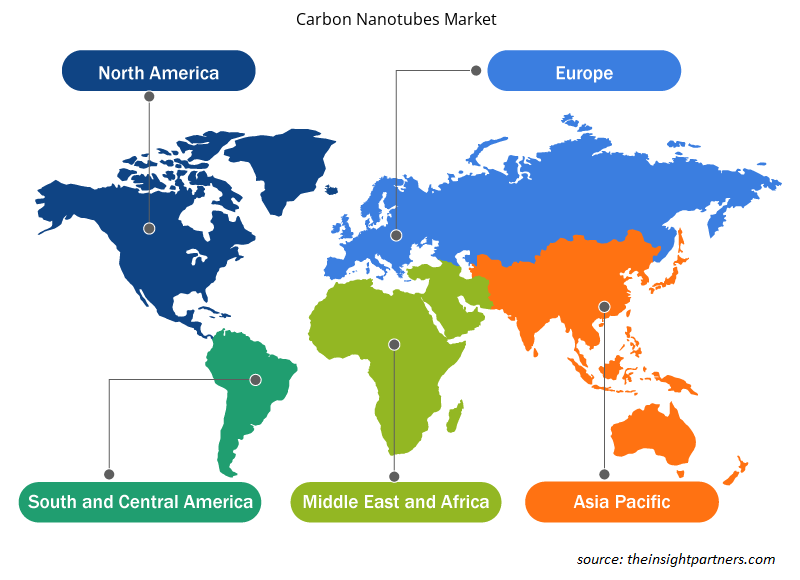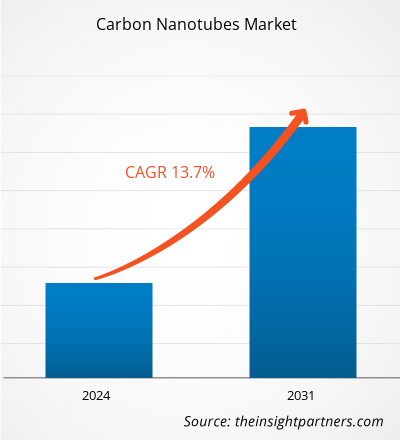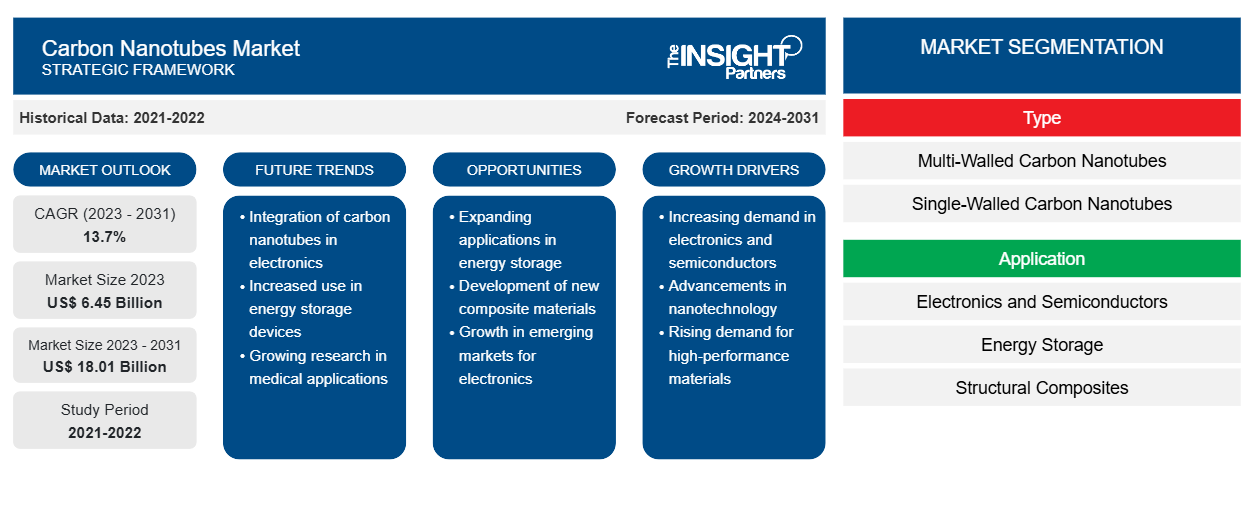Der Markt für Kohlenstoffnanoröhren soll von 6,45 Milliarden US-Dollar im Jahr 2023 auf 18,01 Milliarden US-Dollar im Jahr 2031 anwachsen. Der Markt soll zwischen 2023 und 2031 eine durchschnittliche jährliche Wachstumsrate (CAGR) von 13,7 % verzeichnen. Die Einbindung von CNTs in Nanokomposittinte für den 3D-Druck kann die Funktionalität moderner Druckverfahren verbessern und elektrostatisch ableitende Eigenschaften verleihen.
Kohlenstoffnanoröhren Marktanalyse
Die wachsende Nachfrage nach leichten Metallersatzstoffen mit überlegenen thermischen, elektrochemischen und mechanischen Eigenschaften hat zu einer verstärkten Forschung zur Entwicklung von Verbundwerkstoffen und Verbundmaterialien geführt. Technologische Fortschritte und Mikroanwendungen der nächsten Generation im Elektro- und Elektroniksektor erfordern effiziente und hochfunktionelle Materialien wie CNTs. Darüber hinaus wird die CNT-basierte Verbundwerkstofftechnologie in der Luft- und Raumfahrt, der Verteidigung, der Automobilindustrie und der Infrastrukturindustrie häufig eingesetzt. Die National Aeronautics and Space Administration (NASA) finanzierte ein fünfjähriges Space Technology Research Institute (STRI) namens US-COMP, das 2017 zur Erforschung und Entwicklung von CNT-basierten Verbundwerkstoffen gegründet wurde. Die Forschung konzentriert sich auf die Innovation von leichten, ultrahochfesten Materialien für den Einsatz in Erkundungsfahrzeugen. Darüber hinaus entwickelte Toray Industries Inc. im Jahr 2020 ein drahtloses Kommunikationsverfahren mit einem gedruckten Radiofrequenz-Identifikator unter Verwendung halbleitender CNT-basierter Verbundwerkstoffe, teilweise unterstützt vom japanischen Umweltministerium. Der CNT-Verbundhalbleiter des Unternehmens bietet eine Mobilität von 182 cm2/Vs, verglichen mit kostengünstigen integrierten Schaltkreisen und gedruckten Halbleitern, die eine Mobilität von 20 cm2/Vs bieten.
Marktübersicht für Kohlenstoffnanoröhren
Kohlenstoffnanoröhren sind extrem kleine zylindrische Strukturen aus Kohlenstoffatomen. Sie sind für ihre einzigartigen Eigenschaften bekannt, darunter hohe Zugfestigkeit, thermische Stabilität und gute elektrische Leitfähigkeit. Einwandige und mehrwandige Kohlenstoffnanoröhren sind zwei Arten von Kohlenstoffnanoröhren. Einwandige Kohlenstoffnanoröhren bestehen aus einer einzigen Schicht von Kohlenstoffatomen, die zu einer Röhre gerollt sind, während mehrwandige Kohlenstoffnanoröhren aus mehreren konzentrischen Röhren bestehen. Kohlenstoffnanoröhren werden als Verstärkungsmaterial in Verbundwerkstoffen, als Sensormaterial in Sensoren, als Energiespeicher in Batterien, als Katalysatoren bei chemischen Reaktionen und für biomedizinische Anwendungen verwendet. In der Medizinbranche werden sie zur Arzneimittelverabreichung, für Biosensoren, zur Bildgebung und zur Gewebezüchtung eingesetzt. In der Elektronikindustrie werden Kohlenstoffnanoröhren als Transistoren, Verbindungselemente, Sensoren, Displays, Energiespeicher usw. eingesetzt .
Passen Sie diesen Bericht Ihren Anforderungen an
Sie erhalten kostenlos individuelle Anpassungen an jedem Bericht, einschließlich Teilen dieses Berichts oder einer Analyse auf Länderebene, eines Excel-Datenpakets sowie tolle Angebote und Rabatte für Start-ups und Universitäten.
-
Holen Sie sich die wichtigsten Markttrends aus diesem Bericht.Dieses KOSTENLOSE Beispiel umfasst eine Datenanalyse von Markttrends bis hin zu Schätzungen und Prognosen.
Regionale Einblicke in den Markt für Kohlenstoffnanoröhren
Die regionalen Trends und Faktoren, die den Markt für Kohlenstoffnanoröhren im Prognosezeitraum beeinflussen, wurden von den Analysten von Insight Partners ausführlich erläutert. In diesem Abschnitt werden auch die Marktsegmente und die Geografie von Kohlenstoffnanoröhren in Nordamerika, Europa, im asiatisch-pazifischen Raum, im Nahen Osten und Afrika sowie in Süd- und Mittelamerika erörtert.

- Holen Sie sich die regionalspezifischen Daten zum Kohlenstoffnanoröhrenmarkt
Umfang des Marktberichts zu Kohlenstoffnanoröhren
| Berichtsattribut | Details |
|---|---|
| Marktgröße im Jahr 2023 | 6,45 Milliarden US-Dollar |
| Marktgröße bis 2031 | 18,01 Milliarden US-Dollar |
| Globale CAGR (2023 - 2031) | 13,7 % |
| Historische Daten | 2021-2022 |
| Prognosezeitraum | 2024–2031 |
| Abgedeckte Segmente |
Nach Typ
|
| Abgedeckte Regionen und Länder |
Nordamerika
|
| Marktführer und wichtige Unternehmensprofile |
|
Dichte der Marktteilnehmer für Kohlenstoffnanoröhren: Auswirkungen auf die Geschäftsdynamik verstehen
Der Markt für Kohlenstoffnanoröhren wächst rasant, angetrieben durch die steigende Nachfrage der Endverbraucher aufgrund von Faktoren wie sich entwickelnden Verbraucherpräferenzen, technologischen Fortschritten und einem größeren Bewusstsein für die Vorteile des Produkts. Mit steigender Nachfrage erweitern Unternehmen ihr Angebot, entwickeln Innovationen, um die Bedürfnisse der Verbraucher zu erfüllen, und nutzen neue Trends, was das Marktwachstum weiter ankurbelt.
Die Marktteilnehmerdichte bezieht sich auf die Verteilung der Firmen oder Unternehmen, die in einem bestimmten Markt oder einer bestimmten Branche tätig sind. Sie gibt an, wie viele Wettbewerber (Marktteilnehmer) in einem bestimmten Marktraum im Verhältnis zu seiner Größe oder seinem gesamten Marktwert präsent sind.
Die wichtigsten auf dem Markt für Kohlenstoffnanoröhren tätigen Unternehmen sind:
- Nanoshel LLC
- NanoLab Inc
- Kumho Petrochemical Co Ltd
- Klean Industries Inc
- LG Chem Ltd
Haftungsausschluss : Die oben aufgeführten Unternehmen sind nicht in einer bestimmten Reihenfolge aufgeführt.

- Überblick über die wichtigsten Akteure auf dem Markt für Kohlenstoffnanoröhren
Neuigkeiten und aktuelle Entwicklungen zum Kohlenstoffnanoröhrenmarkt
Der Markt für Kohlenstoffnanoröhren wird durch die Erhebung qualitativer und quantitativer Daten aus Primär- und Sekundärforschung bewertet, die wichtige Unternehmensveröffentlichungen, Verbandsdaten und Datenbanken umfasst. Im Folgenden finden Sie eine Liste der Entwicklungen auf dem Markt für Sprach- und Sprechstörungen:
- Im September 2020 ging Arkema eine Partnerschaft mit der Korea Association of Carbon-Nano Industry ein. Die Partnerschaft mit dem Verband wird Arkema dabei helfen, sein Produktangebot zu verbessern.
- Im August 2020 gab ChemSpec North America eine nicht exklusive Vertriebsvereinbarung mit dem in Belgien ansässigen Unternehmen Nanocyl SA bekannt, um die verschiedenen mehrwandigen Kohlenstoffnanoröhrenprodukte („MWCNT“) von Nanocyl in den USA und Kanada zu bewerben und zu vertreiben.
- Im August 2022 gab LG Chem die Erweiterung seiner Investitionen in Kohlenstoffnanoröhren (CNTs) mit dem Bau der weltweit größten Einzellinien-Produktionsanlage für CNTs bekannt.
- Im März 2023 kündigte Canatu Oy (Vantaa, Finnland), ein Entwickler von Kohlenstoffnanomaterialien, eine Modernisierung seiner Kohlenstoffnanoröhren-(CNT-)Filmproduktion an, um die steigende Nachfrage nach ADAS-Heizprodukten in der Automobilindustrie zu erfüllen. Canatu gab an, dass es seine Step-and-Repeat-(SAR)-CNT-Filmproduktionslinie durch Hinzufügen neuer Reaktorkapazitäten und Erhöhen des Automatisierungsgrades verbessert habe.
- Im April 2020 gab OCSiAl bekannt, dass es aufgrund der aktualisierten Unterlagen des Unternehmens im Rahmen der EU-Verordnung „Registrierung, Bewertung, Zulassung und Beschränkung chemischer Stoffe“ (REACH) bis zu 100 Tonnen seiner einwandigen TUBALL-Kohlenstoffnanoröhren jährlich in Europa vermarkten kann und zusätzlich den neuen Anhängen zu Nanoformen entspricht.
Marktbericht zu Kohlenstoffnanoröhren: Umfang und Ergebnisse
Der Bericht „Marktgröße und Prognose für Kohlenstoffnanoröhren (2021–2031)“ bietet eine detaillierte Analyse des Marktes, die die folgenden Bereiche abdeckt:
- Marktgröße und Prognose auf globaler, regionaler und Länderebene für alle wichtigen Marktsegmente, die im Rahmen des Projekts abgedeckt sind
- Marktdynamik wie Treiber, Beschränkungen und wichtige Chancen
- Wichtige Zukunftstrends
- Detaillierte PEST/Porters Five Forces- und SWOT-Analyse
- Globale und regionale Marktanalyse mit wichtigen Markttrends, wichtigen Akteuren, Vorschriften und aktuellen Marktentwicklungen
- Branchenlandschaft und Wettbewerbsanalyse, einschließlich Marktkonzentration, Heatmap-Analyse, prominenten Akteuren und aktuellen Entwicklungen
- Detaillierte Firmenprofile
- Historische Analyse (2 Jahre), Basisjahr, Prognose (7 Jahre) mit CAGR
- PEST- und SWOT-Analyse
- Marktgröße Wert/Volumen – Global, Regional, Land
- Branchen- und Wettbewerbslandschaft
- Excel-Datensatz
Aktuelle Berichte
Erfahrungsberichte
Grund zum Kauf
- Fundierte Entscheidungsfindung
- Marktdynamik verstehen
- Wettbewerbsanalyse
- Kundeneinblicke
- Marktprognosen
- Risikominimierung
- Strategische Planung
- Investitionsbegründung
- Identifizierung neuer Märkte
- Verbesserung von Marketingstrategien
- Steigerung der Betriebseffizienz
- Anpassung an regulatorische Trends























 Kostenlose Probe anfordern für - Markt für Kohlenstoffnanoröhren
Kostenlose Probe anfordern für - Markt für Kohlenstoffnanoröhren